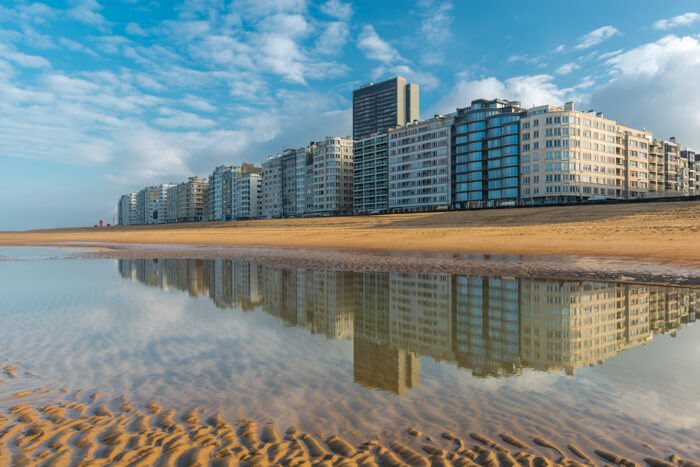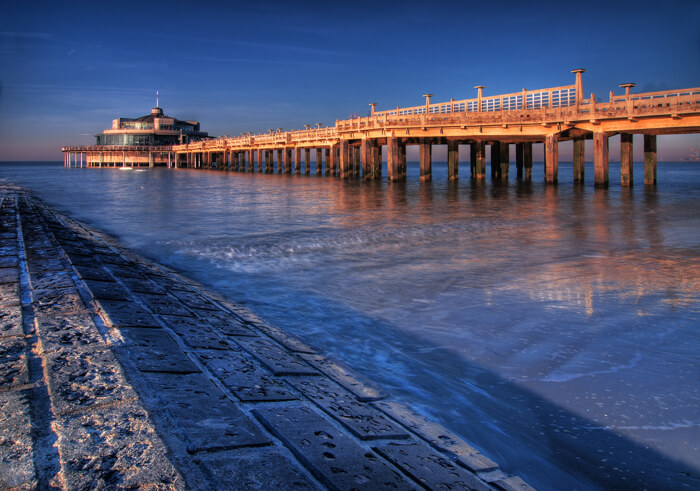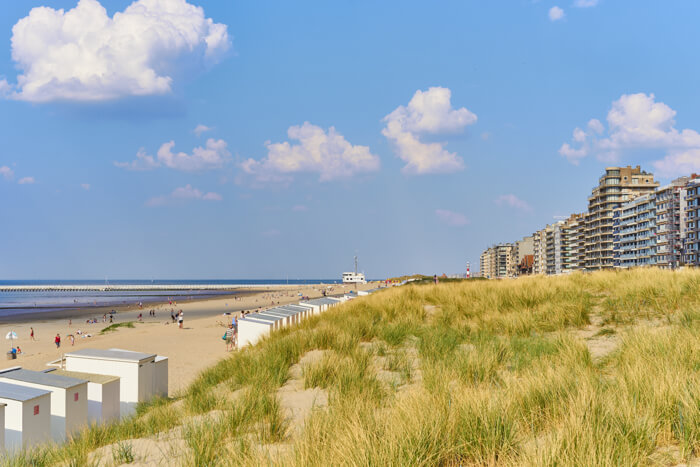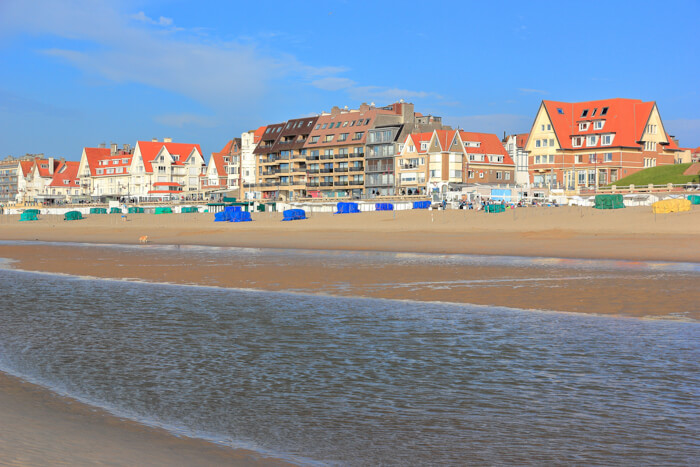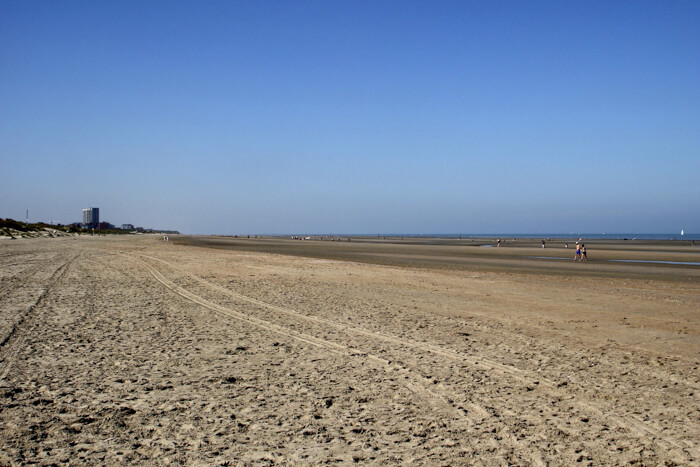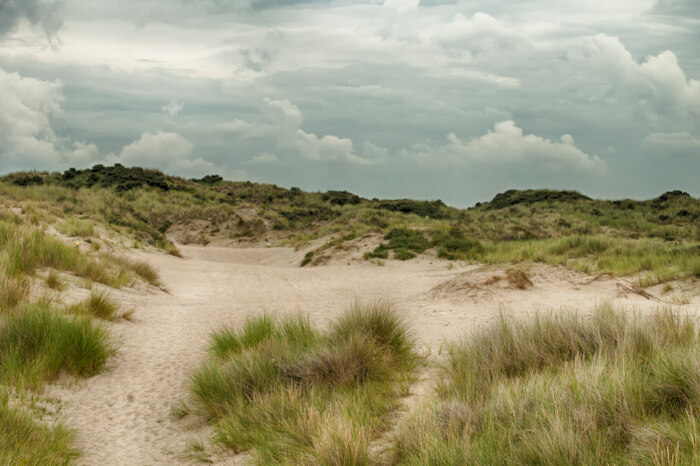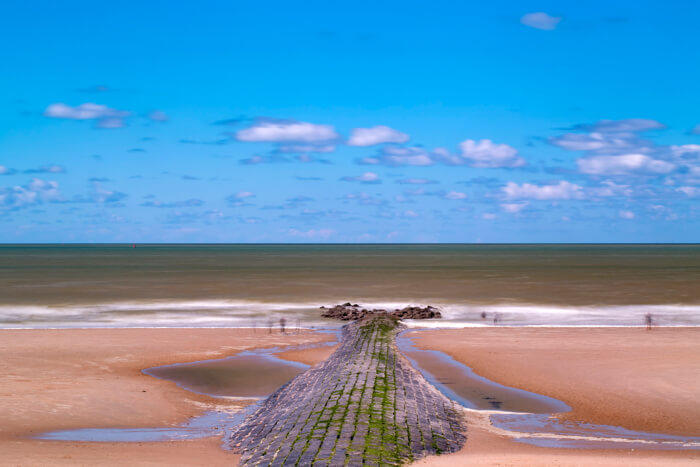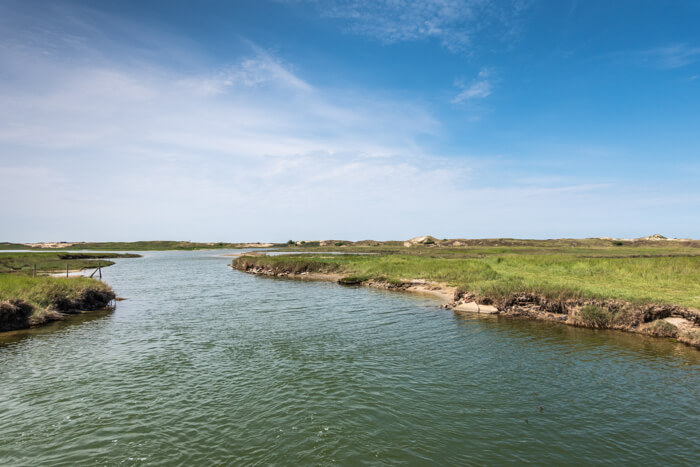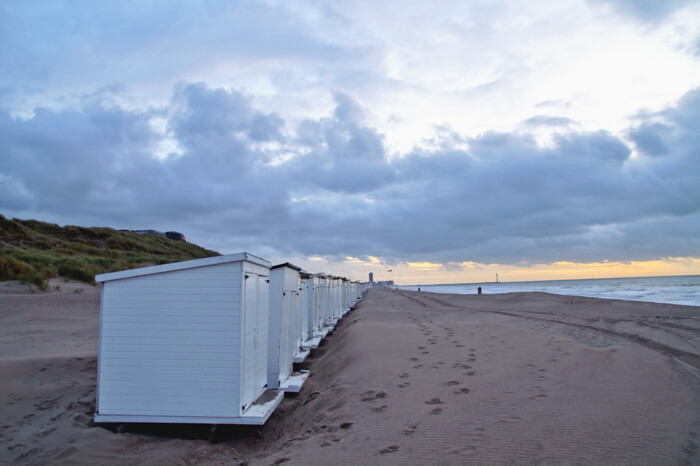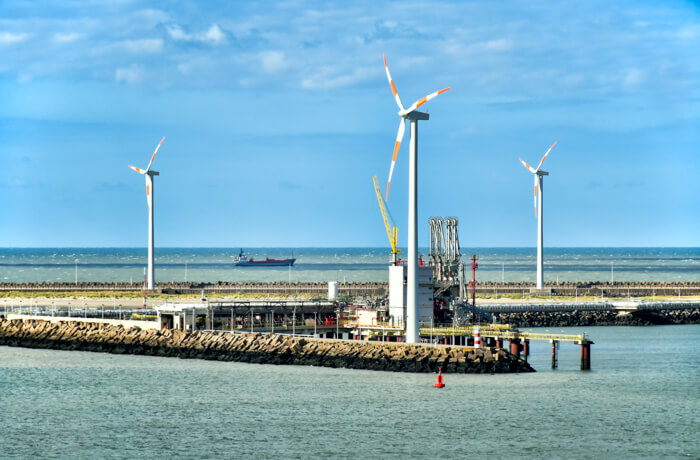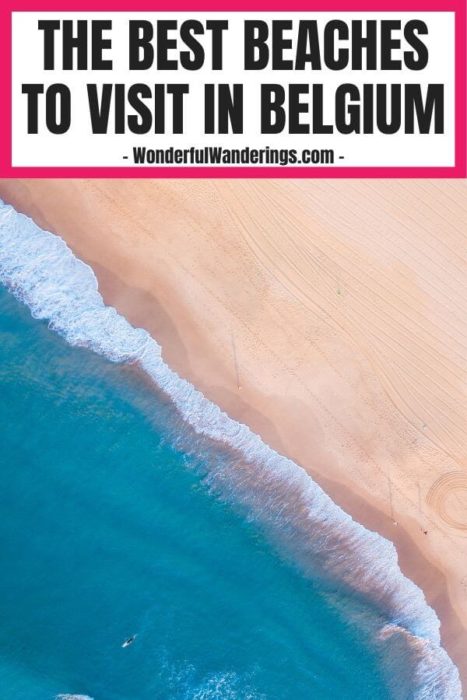If you’ve ever wondered if there are any nice beaches in Belgium, you’re in for a treat. The Belgian coast is over 65 km (40 miles) long, stretching from De Panne near the French border all the way up to Knokke-Heist by the Netherlands. This ribbon of white sand is home to some beautiful beaches and Belgian coastal resorts to enjoy.
The entirety of the Belgian coastline is found in Flanders and faces onto the North Sea. Because of this, the Belgian beaches themselves don’t differ massively. However, they’ve been developed in different ways – some for tourism, some for the fishing industry, some for natural habitats. There is even a nudist beach. The villages, towns, and Belgian coast cities that support them are pretty varied, giving a nice variety of different beach holidays.
The beaches in Belgium are all connected by a coastal tram system called De Kusttram. It’s one of the longest trams in the world with 68 stops in total and takes around two and a half hours to travel from one end to the other. It’s pretty regular, stopping every 10 to 20 minutes.
Traveling from beach to beach you’ll see a wide range of public art. These installations are part of the Beaufort Triennial – an art project that commissions exciting new creations along all the beaches in Belgium.
Contents
- 1. Ostend beach
- 2. Blankenberge beach
- 3. Nieuwpoort beach
- 4. De Haan beach
- 5. Oostduinkerke beach
- 6. De Panne beach
- 7. Middelkerke / Westende beach
- 8. Knokke-Heist beach
- 9. Bredene beach
- 10. Zeebrugge beach
1. Ostend beach
Ostend (also spelled “Ostende” and “Oostende”) is the only proper Belgian coastal city, and it is one of the most popular of all the seaside resorts in Belgium. It’s super easy to get to from Bruges – the train takes only 15 minutes. The journey from Brussels takes just over an hour but trains leave every 30 minutes.
There are 9 km (5.5 miles) of wide sandy beaches here, where all the usual holiday-making takes place. Although it might not be considered the prettiest Belgium beach, it is a great spot if you want to combine seaside activities with a vibrant city atmosphere.
Chic restaurants, bars, and shops are aplenty here, and the city is home to a glamorous harbor bursting with life. There is also a large selection of city museums, such as the Museum of the Sea (or Mu.ZEE), the James Ensor Museum, and the Amandine Ship. If you’d rather stay outside, consider this two-hour art and architecture walking tour.
Ostend, Belgium is also home to the Sand Sculpture Festival which takes place annually in the months of July and August. International sculptors from all over the world travel to the city’s coast to leave their mark on the beach, resulting in a staggering 150 works of art carved from sand all along the seafront.
Another popular Ostend festival is the Theater on the Sea (TAZ Festival) which combines live music, dance, and literary debate in one almighty celebration of culture each August.
The city has a fascinating history, and particularly during the world wars. In World War I, Ostend was occupied by the Germans and became an important port for the launching of submarines and other naval forces. You can follow a trail of audio guides throughout the streets to learn more about the city’s past.
Fishing has long been the main source of income for Ostend’s residents, and it remains one of the best places in Belgium for seafood – particularly the local mussel and shrimp croquettes. If you want to get even closer to the maritime way of life, there are also fishing boat excursions that you can participate in, and take home everything you catch.
2. Blankenberge beach
Blankenberge is another favorite seaside in Belgium for not just locals but plenty of other nationalities too – especially popular among the Dutch and Germans. It’s full of life and luxury, as it was once the personal holiday resort of the Belgian royal family.
The art-deco Belgium Pier takes center stage, jutting out 350 meters (1150 feet) into the North Sea. The Sea Life Marine Park is an amazing aquarium to visit (and one of the largest in Belgium) complete with seal sanctuary.
As well as a plethora of water sport activities and beachfront games, the nightlife in Blankenberge is particularly sought after. Bars and restaurants have a lively atmosphere, including bars with huge terraces on the beach. The high-rise seafront is home to a wide selection of hotels and apartments that overlook the North Sea.
The Belle Epoque Centrum here in Blankenberge is a mine of information. It’s an interactive museum on the development of the Belgium coastal towns, and the innovative era of design that was so important in Belgium and France before the First World War.
3. Nieuwpoort beach
Nieuwpoort is known for two things – seafood and water sports. It’s an old fishing village and medieval port that has now become a rather swanky tourist destination. Divided into two parts – the old town with cobblestone streets and the modern coastal side with its glamorous fish restaurants and hotels.
The town of Nieuwpoort has been subject to a great number of sieges and has been rebuilt and renewed over and over. This has only seemed to add to its character, and it is an atmospheric town to roam through and explore.
There are a handful of interesting sites worth checking out, including the (recreated) bell tower of Nieuwpoort that is now a UNESCO World Heritage Site, the Nieuwpoort lighthouse, and the old fish auction hall.
The auction hall is called “Vismijn” apparently because bidders would shout “mijn” (“mine”) in the days before electronic bidding! Wholesale fish auctions take place early in the mornings on Mondays, Wednesdays and Fridays, dispersing the trawlers’ catches to the numerous restaurants and fishmongers along the front.
For drinking in the ambiance of the town, there’s no better place than the stunning market square (Marktplein) where there’s a weekly market every Friday morning.
A striking art installation called “Le vent souffle où il veut” (“The wind blows where it pleases”) created by Daniel Buren for the Beaufort Triennial can be seen near the marina. It’s an artificial forest of one hundred colorful windsocks that cuts an impressive shape on the skyline.
4. De Haan beach
One of the factors that makes De Haan stand out from the rest of this list of Belgium seaside towns is its low skyline. Unlike the other beach resorts that experienced destructive wartime bombing, this charming village in the municipality of the same name has retained much of its beautiful Belle Epoque architecture and has a notable lack of high-rise buildings. Tea rooms, hotels, ice cream parlors, even the tram station itself – all stunning examples of nostalgic architecture.
The beach at De Haan is, like the rest of them, a dreamy expanse of sand. It is the longest beach on the Belgium coast at 12 kilometers (7.5 miles) in length and backs onto gorgeous forested dunes (Duinbossen) with great hiking trails. It stretches along to the picturesque village of Wenduine, a little haven of soft sand, seafood and spas.
In the summer months, the beaches here are dog-free, and there is a multitude of fun activities like paddle-boarding, windsurfing, and water-skiing. If you fancy a little trek, you can check out the nature park nearby.
Interestingly, someone that briefly called De Haan home was Albert Einstein, who lived here for six months in 1933 after fleeing Nazi Germany. You can still see the house where he lived, and there’s a statue of him sitting on a bench outside.
While you’re here, check out the urban park La Potinière, the goat farm Reigershof Klemskerke, and the little red-roofed pavilion on the dunes called Spioenkop. This gives fantastic panoramic views of the coastal plains, beaches, and polders around it.
5. Oostduinkerke beach
Calling all seafood lovers! Oostduinkerke, in the municipality of Koksijde, is famous for its ancient fishing practices and abundance of shellfish. At low tide, the beach here stretches out as far as 1 kilometer (0.6 miles).
Its name literally translates as “East Dunkirk” and it lies just a short way along the coast from the French industrial city of the same name, with De Panne in between. The “East” was added in the 13th century to differentiate between the two towns.
The presiding image of Oostduinkerke is that of the horseback shrimp fishermen. This is a 500-year old tradition of catching gray shrimp by dragging nets behind sturdy Belgian horses as they walk amid the waves. It’s a practice that has now become part of the UNESCO list of “Intangible Cultural Heritage of Humanity”. Between April and September, you can see this local tradition take place, and sometimes sample some of the catch.
As well as witnessing this piece of history play out on the beach, you can visit the National National Fisheries Museum which shines a light on fishing practices throughout the ages in Belgium. Other interesting and unique museums include The Key and Lock Museum, the museum of regional history Krekelhof, and the folklore museum Florishof.
6. De Panne beach
The coastal town of De Panne is right next to the French/Belgian border. A unique part of the country with huge expanses of dunes stretching inland from the sea, the scenery at this coastal area is absolutely stunning. De Panne beach is also known for being the widest on Belgian’s coast making it a sand-yachting hotspot.
Its location and terrain have carved out this area’s enthralling history – the dunes between here and Dunkirk, just over the border, being the site of evacuation for British soldiers in World War II. The beaches of De Panne were also where the first King of the Belgians, King Leopold I, first set foot in the country in 1831.
Although De Panne does tick the box for all the usual attractions (eateries, bars and water sports), really this is one of the best beaches in Belgium for nature lovers and adventurers. The dunes are home to an extensive nature reserve that is populated with migratory birds and some lovely flora and fauna.
Walking and cycling routes are great around here and will give you a peaceful respite from the hustle and bustle of busier towns and cities of Belgium.
7. Middelkerke / Westende beach
The two seaside towns of Middelkerke and Westende can be found somewhere in the middle of the Belgian coast. Westende is a borough that is split in two – Westende-bad (the beach) and Westende-dorp (the town). Westende is connected to Middelkerke by six miles of sandy beach. They are generally considered family-oriented coastal destinations because of all the beach activities, mini-golf, and play areas for children.
Middelkerke is the larger of the two. It’s principally a resort town and as such offers a bit of everything, from sunbathing and watersports, to shopping and fine-dining.
The Casino right in the center of the promenade has been an attraction for the past 70 years. You can also rent beach equipment like sun loungers and umbrellas. If you want to get away from modern life, you can always rent a bike and head off into the beautiful surrounding countryside.
For the most part, the architecture is fairly recent, as sadly much of the Belle Epoque era seafront was destroyed in World Wars I and II. However, there are a few remnant gems, including the decadent Grand Hotel Bellevue (nicknamed “the roundabout”) – the only building that was built before the First World War.
Another is the Villa Les Zéphyrs Museum which stands testament to bygone times. This listed Art Nouveau villa was built in the early 1900s, originally designed by Ghent’s beloved architect Oscar Van de Voorde. It has since been restored and its inviting interior tells the story of a typical Belgian family holiday in the 1930s. Today, the building is also the Westende tourist information center.
Dotted all the way along the promenade from Middelkerke to Westende-bad are statues of Belgian comic book characters. Each year a new bronze statue of a familiar cartoon is added to the collection, from Jommeke, Lucky Luke, Kiekeboe, Lambik and many more. There is even a comic book festival here in the summer.
There are some amazing works of Beaufort public art along the seafront to keep an eye out for. There’s “I Can Hear It”, the twin gramophone-trumpets of Ivars Drulle, where you can listen to the sounds of the sea. A huge paint-splash of a sculpture called “Olnetop” stands in the dunes, created by Nick Ervinck. You can get great views from the striking Warande Tower.
8. Knokke-Heist beach
Knokke-Heist is the region at the furthest northern point of the Belgian coast, abutting the border of the Netherlands. It’s developed a reputation as being the St Tropez of Belgium, with a VIP atmosphere for the luxury-seekers. It’s only 30 minutes by car from Bruges, 20 minutes by train.
This upmarket town is the place to go for the most glamorous of hotels and fine-dining experiences. This isn’t to mention high fashion boutiques like Louis Vuitton and Hermès and over 50 art galleries. The restaurants in Knokke-Heist are great too – fresh fish is on all the menus here.
The beach is long and stunning – stretching for 11 km (7 miles), and split into five sections – Heist, Duinbergen, Albertstrand, Knokke, and the Zoute. Pastel-colored beach huts and striped blue and white beach seats paint a very charming scene. Sports and games are big here, from windsurfing, sailing, and yachting to beach volleyball.
This region is also where you’ll find one of Belgium’s best nature parks – Het Zwin Nature Reserve. Zwin is a totally unique salt marsh area near the beach, where a specific combination of natural factors creates the perfect habitat for many rare birds and plants.
There are some great walking trails around the reserve that offer amazing insights into a totally different world. Being by the coast, it’s a very different area to go hiking in Belgium than more
9. Bredene beach
Bredene is found almost halfway along the Belgian coast, sandwiched between Ostend and De Haan. It’s a smaller beach area than the others on this list, and the town itself is not the main feature by a long stretch. The beauty of this destination is its simplicity and beauty – it’s all about the sea and sand. This in mind, it’s not one to choose if you’re seeking a lively nightlife atmosphere!
There’s no main boulevard on the seafront here, just the beach and its beautiful dune system. You won’t find teeming crowds or a beach peppered with sun loungers. Because of this, Bredene makes a good spot to find accommodation if you want to explore other Belgian coastal towns. Its situation in the center of the shoreline means it’s an excellent base to pivot from. A short hop on the Belgium coastal tram gets you to cultural and vibrant cities in no time.
One thing that’s good to know – Bredene is home to the only nudist beach on the Belgium coastline.
10. Zeebrugge beach
If you look at a Belgian coast map, you’ll see that there’s one bit that sticks out into the North Sea towards the border of the Netherlands. This is Zeebrugge.
Belgium’s most important fishing port, this town is also a major ferry terminal. Its artificial harbor links mainland Europe to England, making a day trip to London really easy from here. Or you could just go seal wachting!
Ostend is known locally as the “fish capital”, the wholesale fish market here is one of the largest in Europe. The fishmongers and fishermen here are a historic feature that hasn’t budged over the centuries – amazing to see in action.
The port is linked in many ways to the city of Bruges, for which it acts as a port. 12 km (7 miles) of canal connects the two, transporting imported goods and cargo. Because of this, it’s a great place to head to if you want to combine a bit of North Sea coast with Bruges itself, as they’re both so closely linked.
As well as an exciting harborside to explore, Zeebrugge has a wonderful sandy beach, a myriad of local restaurants (and you can bet the fish is fresh!), and plenty of other cultural things to do. It’s also proud to be the only beach area in Belgium that has plenty of free parking, which is not something to be sniffed at.
What is the Belgium Coastline?
The Belgium Coastline is 65 km (40 miles) long. It spans from the town of De Panne on the border with France to Knokke-Heist on the border with the Netherlands. The coastline runs along the North Sea and is home to sandy beaches and beach resort towns. Some of the notable beach resorts along the Belgium Coastline are Ostend, Blankenberge, De Haan, Oostduinkerke, Nieuwpoort, Middelkerke/Westende, Knokke-Heist, Bredene and Zeebrugge. The coastline of Belgium features wide sandy beaches lined with beachfront properties, restaurants, shops and attractions. Much of the coast was developed and built up in the early 20th century in the popular Belle Époque architectural style. The coast is a popular domestic tourist destination for Belgians as well as some foreign visitors. An extensive tram system called the Kusttram runs the entire length of the coastline with stops in each resort town. The coastline also played an important role during the World Wars when it was occupied by German forces. Remnants from the wars such as bunkers and memorials can still be seen along the coast today.
What is the best beach in Belgium?
The best beach in Belgium is De Haan. De Haan is known for its long sandy beaches and beautiful seaside views. De Haan beach is a 12 km long beach shelves gently into the sea, making it ideal for families. De Haan also offers charming villas, coastal trails, cycling routes and traces of Albert Einstein’s time there. With family-friendly amenities, architectural interest, and natural beauty, De Haan stands out as an exceptional beach town on the Belgian coast.
What is the most famous beach in Belgium?
Ostend Beach is considered the most famous beach in Belgium. It is located in the city of Ostend and stretches across multiple sections for a total length of around 7 kilometers. Ostend Beach is one of the most popular seaside resort destinations in Europe and draws many visitors from nearby cities like Brussels, which is only a 30-minute train ride away. Trains leave for Ostend frequently, making it very accessible. Ostend Beach is well-known for hosting Belgium’s annual Sand Sculpture Festival each summer in July and August. Sculptors from around the world come to create impressive sand art along the waterfront. The beach also hosts the lively Theater Aan Zee festival which celebrates performing arts and culture.
With its wide expanse of soft golden sand and a vibrant seaside boardwalk lined with restaurants, shops and cafes, Ostend Beach offers a classic beach holiday experience. The beach has ample amenities like showers, changing areas and beach supply vendors. Sections like Klein Strand and Groot Strand (Large Beach) are the most crowded. The 2 km long Groot Strand is Ostend’s busiest section. Further west along the coastline, Ostend Beach becomes quieter at Mariakerke Beach and Raversijde Beach. These areas have fewer amenities but offer more space to relax. Oosterstrand Beach sits on the opposite eastern end near Fort Napoleon and is also less crowded than the main central beaches.
Ostend Beach is considered Belgium’s most famous and popular seaside destination. Its accessibility, amenities and range of beach environments draw local and international visitors alike.
Can you swim in Belgium beaches?
Yes, you can swim in most Belgium’s beaches. Belgium has a 68km long coastline along the North Sea with sandy beaches dotted with seaside resort towns. The water temperature ranges from 18-23 degrees Celsius during summer, making swimming quite enjoyable. However, swimming is only allowed when lifeguards are present, generally from June to August. Popular supervised swimming beaches include De Panne, Ostend, Blankenberge, and Knokke-Heist. Watch for the green flags indicating it’s safe to swim. The beaches have good facilities like showers, changing areas, and equipment rentals. It’s important to be respectful of nature by staying in permitted swimming zones. Don’t forget sunscreen as the sun can be quite strong. Swimming in Belgium’s varied beaches and waterways is a fun way to cool off during the summer months. Just be sure to follow safety precautions and lifeguard instructions. With ample coastline and scenic swim spots, Belgium offers the chance to enjoy swimming surrounded by natural beauty.
How warm is the sea in Belgium?
The sea temperature in Belgium ranges from 18-23 degrees Celsius during summer, which makes it quite pleasant for swimming. The highest temperatures are generally in August. However, the water is colder in spring and fall, dropping to around 10 degrees Celsius. So, summertime is the best season for swimming in the sea at the Belgian beaches.
What are the top things to do in Belgium besides the beaches?
Listed below find the top things to do in Belgium besides the beaches:
- Rafting or Kayaking in the Ardennes: Navigate the rivers of the Ardennes, especially the Lesse, Ourthe, and Semois. Experience diverse terrains, from calm waters to challenging rapids.
- Attend a music festival: Attend Belgium’s vibrant festival scene. Events include the world-famous Tomorrowland, historical Gentse Feesten, and diverse Dour Festival.
- Ghent boat trip: Experience Ghent from its canals. Tours reveal historical sights like the Gravensteen and Old Butcher’s Hall, mainly from Graslei and Korenlei harbors.
- Durbuy Labyrinth: Navigate a massive maze in Barvaux near Durbuy, with varied annual themes and added attractions, including eco-gardens and wooden labyrinths.
- Chocolate-making Workshop in Brussels: Dive into Belgium’s chocolate culture. Workshops in Brussels teach the art of chocolate-making, producing mendiants and pralines.
What do you need to know about Belgium as a tourist?
As a tourist in Belgium, there are a few important things to know. Firstly, Belgium has three official languages: Dutch, French, and German. While English is widely spoken, it’s always helpful to learn a few basic phrases in the local language. Secondly, many shops and businesses in Belgium close on Sundays, so it’s important to plan accordingly. Secondly, some museums and attractions may have specific closing days or limited hours, so it’s advisable to check their schedules in advance. Lastly, Belgium is generally a safe country to visit, but it’s always wise to take common precautions and be aware of your surroundings. These are just a few key things to know before visiting Belgium. It’s always a good idea to do some research and plan ahead to make the most of your trip.
What are the best cities to visit in Belgium as a tourist?
Listed below are the best cities in Belgium to visit as a tourist.
- Brussels: Brussels is the capital and largest city of Belgium. It is known for its cosmopolitan culture, vibrant nightlife, and excellent shopping opportunities. Additionally, Brussels is home to the headquarters of the European Union, adding to its international appeal.
- Bruges: Bruges is an incredibly well-preserved medieval city that looks like it’s straight out of a fairytale. With its charming canals, picturesque stone buildings, and cobblestone streets, Bruges is a must-visit destination for any tourist.
- Ghent: Ghent is a historic city with a rich cultural heritage. It boasts stunning medieval architecture, including its famous Saint Bavo’s Cathedral and the Gravensteen Castle. Ghent is also known for its vibrant arts scene and lively atmosphere.
- Antwerp: Antwerp is a vibrant city with a thriving fashion and diamond industry. It is home to impressive architectural landmarks, such as the Cathedral of Our Lady and the Antwerp Central Station. Antwerp is also renowned for its fashion boutiques, art galleries, and trendy nightlife.
- Leuven: Leuven is a charming university town with a lively atmosphere. It is famous for its prestigious university, which dates back to the 15th century. Visitors can explore the beautiful Gothic-style Town Hall, visit the renowned Stella Artois brewery, and enjoy the vibrant student culture.
These cities in Belgium offer a mix of history, culture, and unique experiences that make them top choices for tourists visiting Belgium.
What festivals taking place in the beaches of Belgium?
Listed below are the best Belgium festivals taking place in the beaches of Belgium.
- Ostend Beach Festival. Ostend Beach Festival is one of the most well-known beach festivals in Belgium. It is an electronic music festival held annually in July on the beach in Ostend. The festival features DJs and artists playing electronic dance music across multiple stages set up along the coastline. Ostend Beach Festival started in 2010 and has grown into one of Belgium’s biggest beach parties, attracting around 50,000 attendees each year.
- Wecandance. Wecandance is another major beach festival in Belgium is Wecandance, held in August in Zeebrugge. Wecandance offers multiple stages of house, techno, and electronic acts along the North Sea coast.
- Sandcastle Festival. Sandcastle Festival is hosted in Blankenberge every summer, where artists create massive sand sculptures along the beach. The sand sculptures often reach over 10 meters tall and draw both locals and tourists alike.
- W-Festival. The W-Festival takes place in late August on the Klein Strand in Ostend. It’s focused on new wave, synthpop, and 80s music, with past headliners including Nena, The Human League, and Earth Wind & Fire.
Other Belgian beach festivals include the North Sea Beer Festival in Ostend showcasing Belgian brewers and Bomboclat Festival in Zeebrugge focused on reggae music. Many beachside music festivals occur during the summer months to take advantage of the scenic coastal setting.
Can children visit the beaches of Belgium?
Yes, Belgian beaches are very welcoming to children. Most shorelines have gentle waves and shallow waters ideal for young visitors. Lifeguards are on duty at popular beaches. Many beach towns also have promenades with kid-friendly attractions, dining and entertainment. Families will find Belgium’s beaches to be clean, safe and fun for little ones.
Listed below are the most child and toddler friendly beaches in Belgium.
- De Panne Beach. De Panne Beach is very wide with gentle sloping sand, making it great for little ones to play and run around safely. De Panne also has playgrounds and go-cart rentals along the boardwalk to keep kids entertained.
- Blankenberge Beach. Blankenberge Beach is one of the most popular beaches in Belgium for families with young children. This expansive sandy beach has very shallow waters, making it ideal for toddlers and small kids to splash around safely. Blankenberge provides playgrounds right on the sand for children to enjoy. The beach also has areas sectioned off specifically for tiny tots where they can play without worry. Along the promenade are amusement park rides and kid-friendly restaurants to keep little ones entertained.
- De Haan beach. De Haan is a top beach for families is De Haan on the Belgian coast. De Haan boasts soft sands and gentle waters perfect for babies and toddlers. Kids will delight in the colorful beach huts that line the shore. Parents can rent a beach hut or cabana to provide shade and a home base. De Haan has a children’s seaside pool for splashing around and a mini golf course next to the beach. There are also several playgrounds and parks close to the beach featuring equipment for all ages.
- Bredene Beach. Bredene Beach keeps children engaged with play equipment right on the sand. Further, its location in the middle of the coast makes it a convenient base for exploring other family-friendly beaches via the coastal tram.
Is surfing allowed in Belgium beaches?
Yes, surfing is allowed at beaches in Belgium. The Belgian coastline along the North Sea has over 15 surf spots spread across its sandy beaches, making Belgium a popular surf destination. Top spots include Ostend, Blankenberge, Zeebrugge, Knokke and De Haan which offer surfable waves for all levels. The surf season runs mainly from September to May when the best swell arrives. Wetsuits and thick neoprene accessories are a must for Belgium’s cold waters. Local surf schools and camps operate during summer providing lessons and rentals. While waves are inconsistent, Belgium’s beaches provide an accessible option for European surfers. Belgium has a passionate local surf culture despite facing the fickle conditions of the North Sea.
What are the best beaches near Brussels?
Listed below are the best beaches near Brussels.
- Ostend Beach. Ostend Beach is one of the most popular beaches near Brussels, located just over an hour away by train. With 7 km of sandy beaches and a lively promenade, it offers plenty of amenities like restaurants, bars, museums, and festivals.
- De Panne Beach. De Panne Beach is another top beach near Brussels, about 1.5 hours away. It has wide sandy beaches with beach clubs, and is close to the Westhoek nature reserve. De Panne is also historic as the first place King Leopold I stepped on Belgian soil.
- Knokke-Heist Beach. Knokke-Heist Beach is a good beach option near Brussels, 1.5 hours away. It has luxury resorts and fine dining, along with a nature reserve and 11 km of stunning beaches over 5 sections.
- De Haan Beach. De Haan Beach is 12 km long, the longest in Belgium. Just over 1 hour from Brussels, it has beautiful architecture and sandy beaches backed by forested dunes. Albert Einstein lived here briefly.
The entirety of Belgium’s coastline is connected by the tram Kusttram, making it easy get around the beaches near Brussels.
What are the best beaches near Antwerp?
Listed below are the best beaches near Antwerp.
- Sint-Annastrand beach. is a sandy beach on the Scheldt riverbank in Antwerp. Located within the city, it offers views of the port, MAS museum, and city center. Swimming is prohibited due to strong currents.
- De Nekker beach. De Nekker Sandy Beach in Mechelen is one of the nearest inland beaches to Antwerp at 37 km. Part of a recreation center, it features a gradually sloping lake for swimming. Lifeguards are on duty in summer.
- Hofstade Strand. Hofstade Strand in Zemst is a charming lake beach 20 km from Antwerp. Open in summer, it has designated swimming areas and playgrounds. Hofstade is reachable by direct train from Brussels in 30 minutes.
- Knokke-Heist beach. The long sandy beaches of Knokke-Heist are 60 km from Antwerp, near the Dutch border. Popular but crowded in summer, they offer swimming, water sports, shopping, dining, and resort accommodation.
- De Panne Beach. De Panne Beach is 65 km away, with sweeping white sands near the French border. It allows leashed dogs and has playgrounds, seaside restaurants, and views of migratory birds in a nature reserve.
PIN FOR LATER

